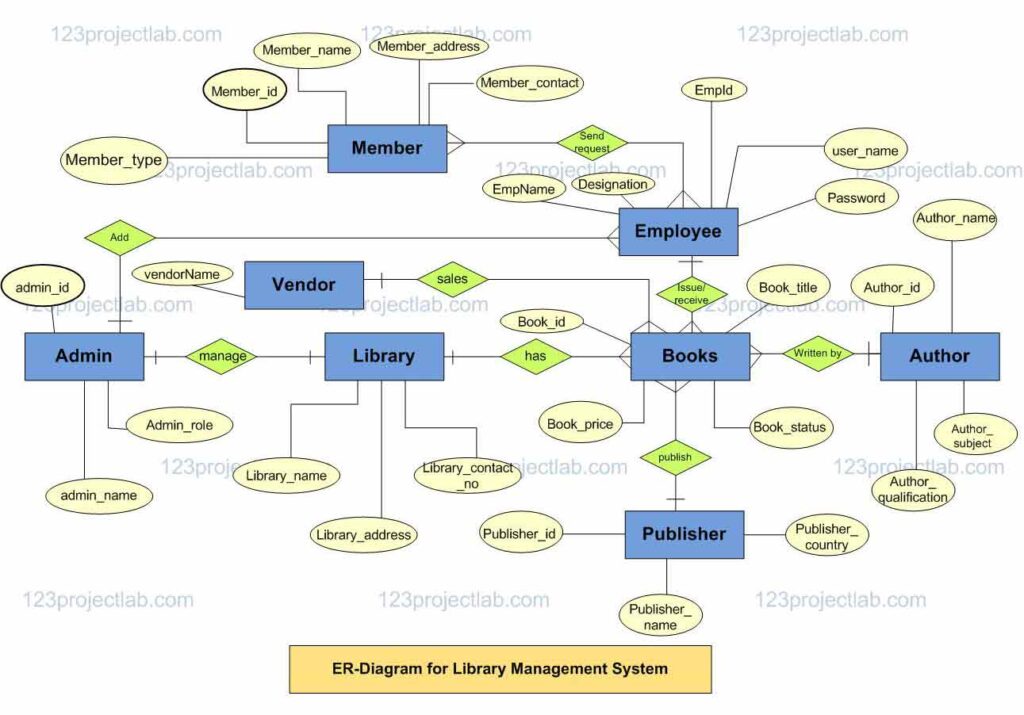The ER (Entity Relationship) Diagram of Library management system is an ER model of online library management system entities. ERD for Library management system is a graphical representation of database tables and relations between library, member, book, admin etc.
The main purpose of ER diagram for online library management system is to represent data objects and their relationships. The main entity of this ER diagram is library, library admin, employee, member, book, vendor, author and publisher.
Checkout: DFD for Online Library Management System
The Library Management System database working is based on the following assumptions-
- The system keeps track of all users with a single point authentication via user id and password.
- The special feature access is granted based on users’ role (such as admin, employee or member)
- The library admin has full control over the entire system. He can add new employee and member. Admin can assign access right to different users.
- Employee of the library maintain book details of the library. They can issue or receive books from library member. Each employee has unique login id and password.
- Each book has unique book id, title, price and book status (available/issued).
- Each vendor has unique id. Similarly, each publisher also has unique publisher id.
- For better database handling we have used ids in the database for any transaction. Such as at the time of book issue/receive we store book id in the database instead of book title and similarly instead of member name we store member id.
- Employee can generate various library reports such as member report, book report, vendor report etc. Such reports are very helpful in decision making.
- The entire system has several checks to avoid mismanagement. Any employee can not again issue a book which is already issued to someone. There is a check that prevents it from doing so.
- Similarly, entry of any master record such as book, member, vendor, author or publisher can not be deleted if its related record exists in any transaction table.
Library Management System Entities and their Attributes
Each of the entities have their respective attributes which are:
- Admin:-admin_id, admin_name, admin_name
- Library:- library_name, library_address, library_contact_no
- Books:-book_id, book_title, book_price, book_status
- Author:-author_code, author_name, author_qualification, author_subject
- Member:-member_id, member_name, member_address, member_contact, member_type
- Employee:-emp_id, emp_name, emp_designation
- Vendor:- vendor_code, vendor_name
- Publisher:-publisher_code, publisher_name, publisher_country
Database Detail of Online Library Management System
- Each entity in the system contains a primary key and unique key.
- We have implemented indexing on each table for faster query execution.
- There was some data redundancy. So, we normalized all entities (such as admin, employee, member, library, book, author, publisher, vendor).
- Book master table store all books data.
- Member master table store record of all library member.
- Issue receive table store all book transaction details.
- Author, publisher and vendor tables contain records of author, publisher and vendor records respectively.
- 1:M and 1:1 relationship exists in the database.
Download Library Management System Synopsis pdf Now
ER Diagram for Library Management System
This is the ER model of Library management system. The entities are represented in boxes and their attributes are represented in oval shape. The relationships between various entities are represented by diamond shape.
This diagram is drawn in Microsoft Visio software. There are many diagram designing tools. You can know best flowchart software and diagramming tools and easily draw ER diagram for Library management system online.

- ER Diagram for Library Management System (2024)
- ER Diagram for Online Shopping System
- ER-Diagram for Hospital Management System Project
- ER Diagram for Optical Shop Management System
- ER Diagram for Gas Agency Management System
- ER Diagram for Online Book Store
- ER Diagram for Loan Automation System
- ER Diagram for Visa Application Processing System